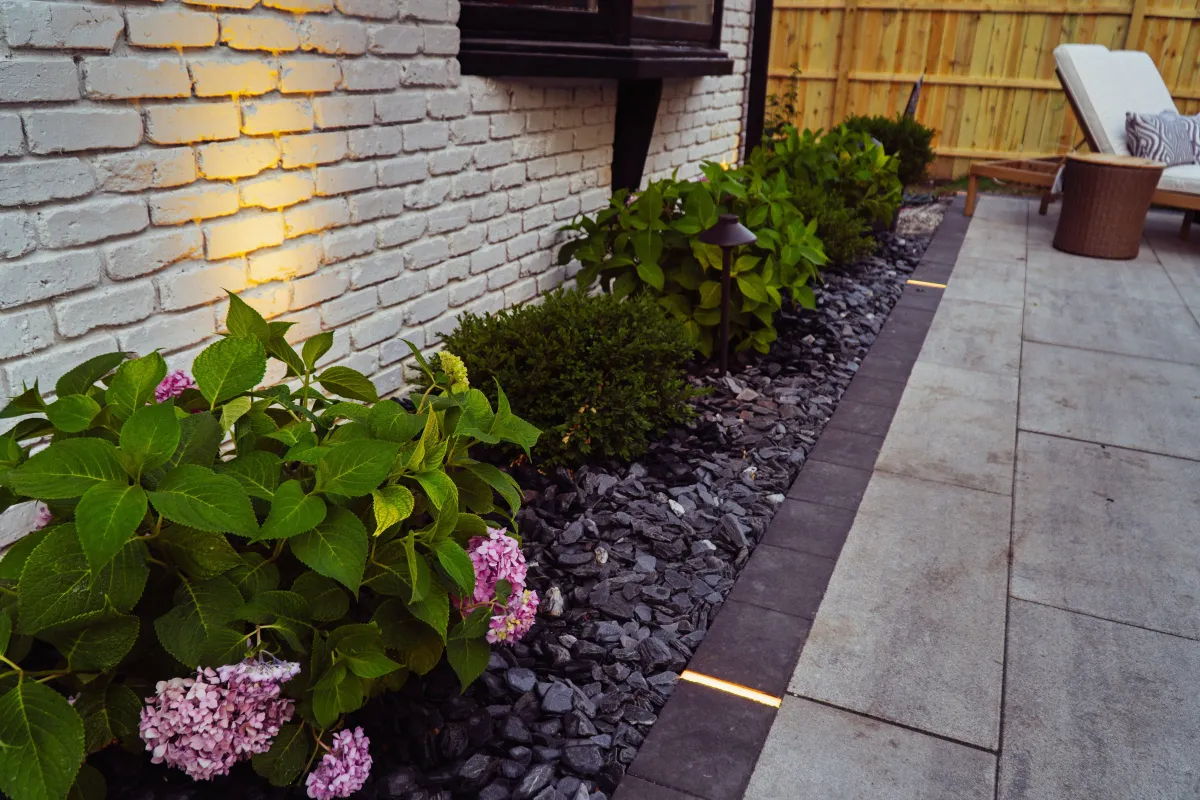Blogs

Can Landscaping Improve Energy Efficiency For Your Property?
Yes, landscaping can significantly enhance the energy efficiency of your property by leveraging various strategies that optimize natural elements. Landscaping Experts Inc. understands the pivotal role landscaping plays in transforming outdoor spaces into energy-efficient havens. With over 30 years of experience, our team is dedicated to creating sustainable landscapes that not only enhance aesthetic appeal but also reduce energy consumption.
Key Takeaways
Strategically planted trees and shrubs provide natural shade, reducing cooling costs.
Evergreen windbreaks mitigate heat loss during winter, lowering heating expenses.
Properly designed landscapes improve air circulation, enhancing overall comfort and efficiency.
Choosing water-efficient plants reduces water consumption and associated energy costs.
Investing in landscaping yields long-term savings and increases property value.
Benefits of Native Plants in Energy Efficiency
Native plants offer numerous benefits when it comes to enhancing energy efficiency in landscaping. These plants are inherently adapted to the local climate and soil conditions, making them well-suited for sustainable landscaping practices that reduce energy consumption and maintenance costs.
Natural Adaptation
Native plants have evolved over time to thrive in specific regions, requiring less water, fertilizer, and maintenance compared to non-native species.
Water Conservation
Due to their adaptation to local conditions, native plants typically have deep root systems that efficiently absorb water, reducing the need for irrigation. This helps conserve water resources and lowers the energy required for pumping and distributing water.
Reduced Maintenance
Native plants are naturally resistant to local pests and diseases, reducing the need for chemical pesticides and herbicides. This decreases maintenance efforts and associated energy use.
Wildlife Habitat
Native plants provide food and shelter for local wildlife, supporting biodiversity and ecosystem health without additional energy inputs.
Improved Air Quality
By thriving in local environments, native plants contribute to improved air quality by filtering pollutants and capturing carbon dioxide.
Enhanced Soil Health
These plants improve soil structure and fertility through their natural growth patterns, reducing erosion and the need for soil amendments that require energy-intensive processes.
Aesthetic Appeal
Native plants often have unique textures, colors, and seasonal changes that enhance the visual appeal of landscapes, reducing the need for energy-intensive ornamental maintenance.
Incorporating native plants into your landscaping design not only promotes energy efficiency but also fosters a sustainable approach to outdoor spaces. Whether you're creating a residential garden or planning a commercial landscape, choosing native species aligns with environmental stewardship and long-term cost savings.
Shading and Cooling Effects of Landscaping
Shading and cooling effects of landscaping are pivotal in reducing energy costs, particularly during sweltering summer months. Strategically planted trees and shrubs create natural shade that significantly decreases the reliance on air conditioning, thereby lowering overall energy consumption.
Trees with Broad Canopies
Species like oak, maple, and birch provide expansive shade that blocks direct sunlight from entering homes. This reduces indoor temperatures and lessens the need for constant cooling.
Shrubs Near Windows
Placing shrubs strategically near windows prevents solar heat gain indoors. This natural barrier minimizes the heat entering through windows, keeping interiors cooler.
Cooler Microclimate
Properly positioned landscaping elements not only shade specific areas but also create a cooler microclimate around the property. This microclimate improves overall comfort and reduces the heat island effect in urban areas.
Temperature Reduction on Surfaces
Shade from trees extends beyond buildings to cover outdoor surfaces like patios and driveways. This not only enhances the usability of outdoor spaces but also reduces heat absorption, keeping these areas cooler.
Effective shading with landscaping is more than just aesthetic; it’s a practical approach to enhancing energy efficiency and creating a more comfortable living environment. By integrating these strategies into landscaping designs, homeowners can enjoy significant energy savings while also improving the sustainability of their properties. Whether for residential homes or commercial buildings, leveraging natural shade through trees and shrubs is a cost-effective way to mitigate energy consumption and promote environmental stewardship.
Windbreaks for Winter Efficiency
Evergreen trees are instrumental in improving energy efficiency during winter by serving as effective windbreaks. These trees strategically placed around your property act as barriers against cold winds, reducing heat loss and the demand for heating.
Dense evergreen foliage creates a protective barrier that slows down and redirects cold winter winds.
Windbreaks can lower heating costs by up to 30% by minimizing heat loss through walls and windows.
Proper placement on the windward side of your home maximizes their effectiveness in blocking wind.
Consider coniferous trees like pine and spruce for their dense foliage and year-round wind protection.
Water-Efficient Landscaping Practices
Designing a water-efficient garden not only conserves water but also reduces the energy required for irrigation, promoting sustainability and cost savings.
Choose native plants adapted to your local climate, requiring minimal watering once established.
Incorporate drought-resistant plants like succulents and native grasses that thrive with little water.
Mulch around plants to retain soil moisture and reduce evaporation, optimizing water use efficiency.
Install drip irrigation systems that deliver water directly to plant roots, minimizing waste.
By implementing these landscaping practices, you can enhance energy efficiency, conserve resources, and create a more sustainable outdoor environment.
FAQs
What are the best trees for shading?
Trees like oak, maple, and birch provide excellent shade due to their dense foliage and large canopies.
How much can landscaping reduce energy costs?
Effective landscaping can reduce energy bills by up to 25% annually, depending on the region and plant selection.
Is landscaping a good investment for energy efficiency?
Yes, investing in energy-efficient landscaping can yield significant long-term savings and enhance property value.
How do I find the best landscaper near me?
Research local landscaping companies, read reviews, and ask for referrals from neighbors or friends.
What should I consider when planning a water-efficient garden?
Consider local climate conditions, plant water requirements, and efficient irrigation methods to minimize water usage.
Enhancing Your Property's Efficiency with Landscaping Experts Inc.
Transforming your outdoor space into an energy-efficient oasis not only improves your quality of life but also contributes to environmental sustainability. Contact us at Landscaping Experts Inc. today to explore how our tailored landscaping solutions can enhance your property's efficiency and beauty.
Discover the benefits of energy-efficient landscaping with Landscaping Experts Inc. Our expert team is ready to assist you in creating a sustainable outdoor environment that saves you money and enhances your property's appeal.

Follow Us
Service Areas
Plainfield
Shorewood
Morris
Lake Forest
Winnetka
Hinsdale
Western Springs
Hinsdale
Service Areas
Wilmette
Northbrook
Montgomery
Deerfield
Saint Charles
Kelinworth
Golf
Campton Hills
Barrington
Hoffman Estates
Copyright © Landscaping Experts Inc. 2024. All Rights Reserved. Privacy Policy. Terms & Conditions. Web Design by Fused Media

